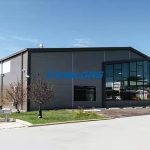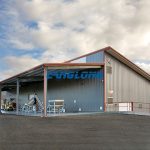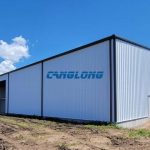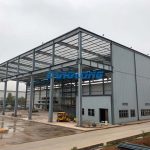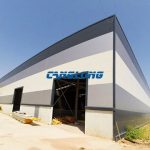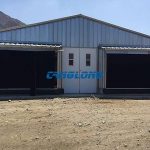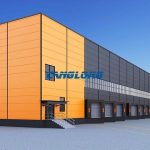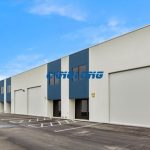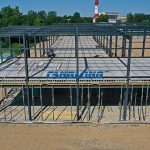Design and implementation plan for metal warehouses in tropical regions
As global trade accelerates its tilt toward emerging markets, tropical regions such as Southeast Asia, Africa, and Latin America are becoming the core growth poles for warehousing logistics, agricultural product processing, and manufacturing. According to World Bank data, the demand for logistics real estate in Southeast Asia will increase by 12% year-on-year in 2023, and the industrial warehousing area in Africa will exceed 120 million square meters. However, extreme climates such as high temperature and humidity, frequent typhoons, and salt spray corrosion have caused traditional warehouses to face three major pain points: mildew of walls, rust of structures, and soaring energy consumption.
Metal warehouses have gradually become the preferred solution in tropical regions due to their lightweight, modular, and customizable characteristics. This article will analyze the core design forms of metal warehouses in combination with the characteristics of global tropical climates, and through the actual combat cases of Canglong Group, reveal how “China Smart Manufacturing” can solve the problem of tropical warehousing.
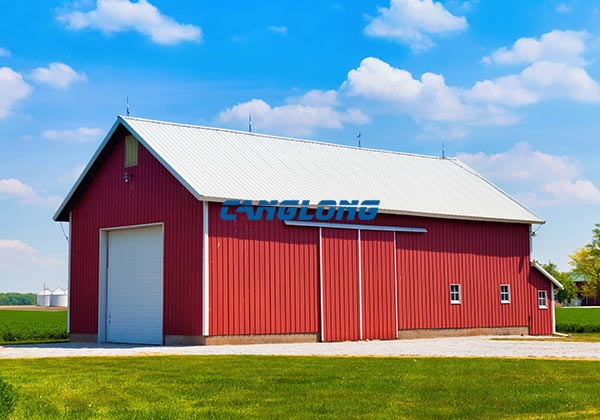
One. Three major climate challenges for metal warehouses in tropical regions
The climate characteristics of tropical regions put forward more stringent requirements on warehouses than those in temperate regions, which are mainly reflected in the following dimensions:
1. High temperature and high humidity: a double test of material weather resistance and thermal insulation
The average annual temperature in Southeast Asia (such as Indonesia and Thailand) is 28-32℃, and the relative humidity exceeds 80%. The humidity in the Congo Basin in Africa and the Amazon Basin in Latin America is even as high as 90%. Under high temperature and high humidity, ordinary color steel plates are prone to cracking due to “thermal expansion and contraction”, and the surface coating of the steel plate is accelerated to oxidize (rust after only 500 hours of salt spray test). At the same time, if the wall is not well insulated, the temperature inside the warehouse can be 8-10℃ higher than that outside, resulting in a surge of more than 30% in the energy consumption of refrigeration equipment.
2. Typhoon/heavy rain: an extreme challenge of structural strength and drainage capacity
The Northwest Pacific and North Atlantic are high-incidence areas of typhoons in the world. The Philippines, Mexico and other places are affected by typhoons above level 8 more than 6 times a year. Tropical rainstorms are often accompanied by strong winds of more than level 12. The light steel keel structure of traditional warehouses is easily deformed due to excessive wind loads. Rainwater backflow can also cause ground subsidence and moisture in goods.
3. Salt spray/insect infestation: special threats to coastal areas and tropical rainforests
The coastal areas of Southeast Asia (such as Vietnam and Malaysia) are affected by the marine climate, with high salt concentrations in the air (chloride ion content exceeds 0.1mg/m³), and ordinary steel will rust in 3 months. In humid and hot areas such as the Amazon rainforest, termite and fungal erosion will cause wooden structure warehouses to collapse within 2 years, and metal warehouses also need additional protection.
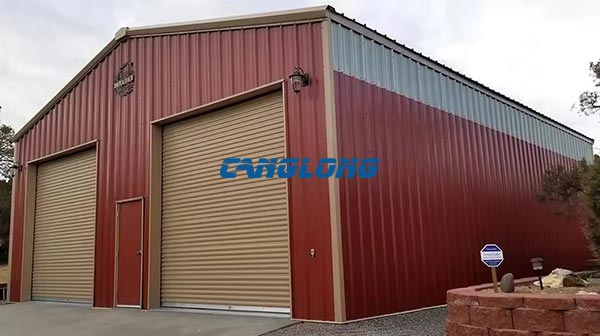
Two. Systematic solutions for tropical metal warehouses
In view of the particularity of tropical climate, the design of metal warehouse need to start from three aspects: material selection, structural reinforcement, and functional adaptation. The following are the four mainstream forms verified by global tropical projects:
1. Rock wool/polyurethane sandwich panel + galvanized steel plate combination
Sandwich panel is the “core armor” of tropical metal warehouses: the outer layer is made of 0.5-0.8mm thick galvanized steel plate (zinc content ≥275g/㎡), and the surface is pre-coated with weather-resistant fluorocarbon paint (salt spray test ≥2000 hours). The middle is filled with high-density rock wool (density ≥120kg/m³) or flame-retardant polyurethane (thermal conductivity ≤0.024W/(m·K)). This design can achieve:
- Insulation and cooling: The thermal conductivity of 100mm thick rock wool sandwich panel is only 0.038W/(m·K), which can make the internal temperature of the warehouse 5-8℃ lower than the outdoor temperature and reduce refrigeration energy consumption by 30%.
- Moisture-proof and anti-corrosion: Galvanized steel plates isolate water vapor penetration, and the water absorption rate of rock wool/polyurethane core materials is less than 1% (ordinary EPS core materials reach 5%), which prevents the wall from mildew caused by condensation water penetration.
- Fire safety: The rock wool core material reaches Class A fire protection (non-flammable when away from fire), and polyurethane is Class B1 (self-extinguishing 3 seconds away from fire), which meets the fire protection regulations for warehousing in tropical areas.
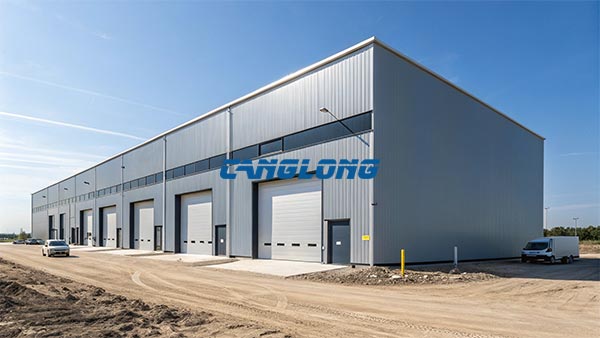
2. Large-span light steel structure
Warehouses in tropical areas often need to store large equipment or stack goods. The large-span design (span of 12-24 meters) can reduce internal columns and improve space utilization. The “H-shaped steel + purlin” light steel structure adopted by Canglong Group reduces its own weight (only 1/20 of the concrete structure) by optimizing the cross-sectional shape (such as variable-section H-shaped steel), and optimizes the roof slope (15°-20°) through “wind tunnel testing” to avoid rainwater backflow during typhoons. For example, a logistics warehouse in the Philippines adopts a 24-meter span design, and the structure has zero deformation when Typhoon Dusurui passes through.
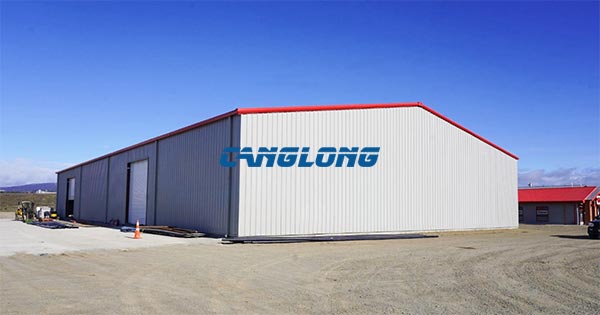
3. Modular prefabrication and assembly
The terrain in tropical areas is complex (such as mangrove wetlands in Southeast Asia and karst landforms in Africa). The construction period of traditional cast-in-place structures is long (3-6 months), and the structure is prone to cracking due to foundation settlement. The modular metal warehouse adopts the “factory prefabrication + on-site bolt connection” mode. The components are cut, welded, and sprayed in the factory, and the main installation can be completed on-site in just 48 hours. The modular project customized by Canglong Group for a Brazilian agricultural product warehouse took only 45 days from ordering to delivery, perfectly matching the construction window before the rainy season.
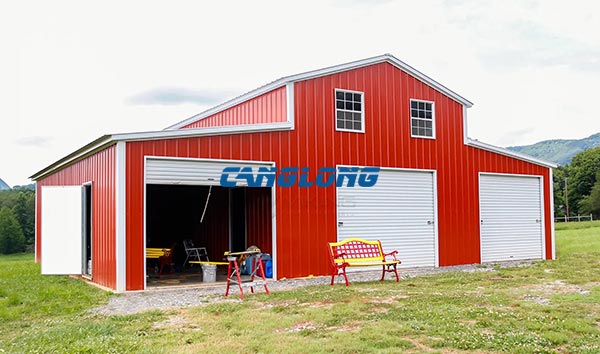
4. Customized ventilation and drainage system
Tropical warehouses need to reduce internal humidity through “natural ventilation + forced dehumidification”. Canglong Group’s design solutions include:
- Roof ventilators: Install unpowered ventilators (air exchange volume ≥1000m³ per hour) on both sides of the ridge to discharge hot and humid air using the thermal pressure effect.
- Water diversion slope and eaves gutter: The roof is designed with a drainage slope of 2%, with deep eaves gutter (width ≥ 300mm) + PVC downpipe (diameter 110mm) to prevent rainwater accumulation.
- Ground moisture-proof layer: The warehouse floor is paved with 0.3mm thick PE moisture-proof membrane + 50mm thick fine stone concrete to prevent underground moisture from returning.
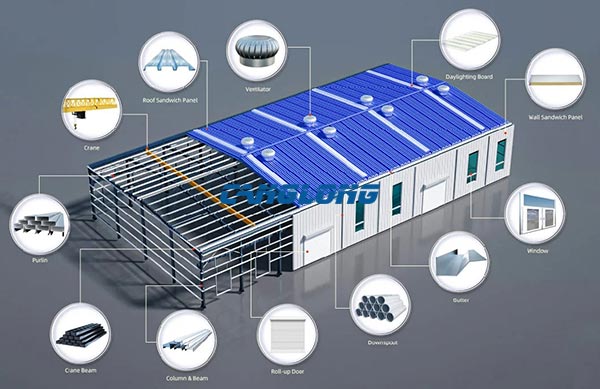
Three. Canglong Group Tropical Metal Warehouse Case
As an enterprise that has been deeply involved in the steel structure construction industry for 17 years, Canglong Group has delivered 50+ metal warehouse projects for 12 tropical countries including Southeast Asia, Africa, and Latin America. The following are 3 typical cases:
Case 1: A cross-border e-commerce logistics warehouse in Manila, Philippines – typhoon resistance + ultra-long weather resistance
Project background: Manila is affected by 6 typhoons per year on average, with a humidity of 90%. Traditional warehouses have wall peeling and structural corrosion in 3 years.
Design solution:
- Use 100mm thick rock wool sandwich panel (galvanized steel plate 0.8mm, fluorocarbon paint) + H-shaped steel large span structure (span 18 meters).
- Roof design 20° slope + non-powered ventilator (install 1 unit per 30㎡), and add water guide grooves on the wall (to prevent rainwater penetration).
- Surface treatment: galvanized layer 275g/㎡ + fluorocarbon coating (film thickness 40μm), salt spray test up to 2500 hours.
Project results: The warehouse has been put into use for 2 years, with no structural deformation and no wall mildew. It only shook slightly when Typhoon “Hai Kui” passed (the structure was tested by a third party for safety), and the customer commented that it was “10 years more durable than local traditional warehouses.”
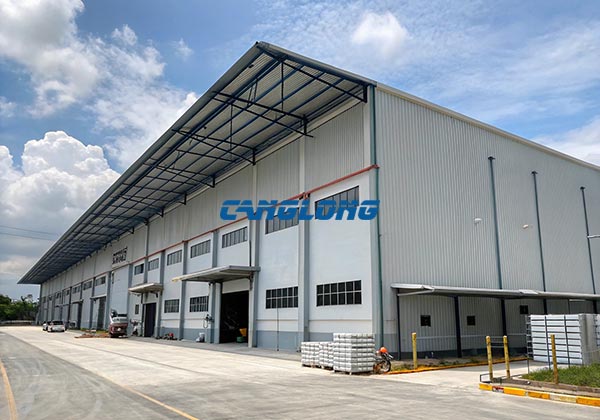
Case 2: Agricultural product processing warehouse in Tema Port, Ghana – moisture-proof + insect-proof
Project background: Ghana is located in the tropical rainforest climate zone, with a humidity of 95%, severe termite erosion, and ground collapse in traditional warehouses within 1 year.
Design solution:
- Double-layer metal sandwich panel (inner layer 0.6mm galvanized steel plate + outer layer 0.8mm aluminum-zinc steel plate), filled with 150kg/m³ high-density rock wool in the middle (thermal conductivity 0.035W/(m·K)).
- The floor adopts a composite structure of “PE moisture-proof film + 3mm thick stainless steel plate” (the surface of the stainless steel plate is coated with anti-termite coating).
- Ventilation shutters are reserved on the wall (with 304 stainless steel mesh installed) to prevent insects and rodents from entering.
Project results: The warehouse has been in operation for 18 months, with no ground settlement, no mildew on the wall, and 0 termite erosion rate, becoming the “core hub warehouse” for Ghana’s agricultural product exports.
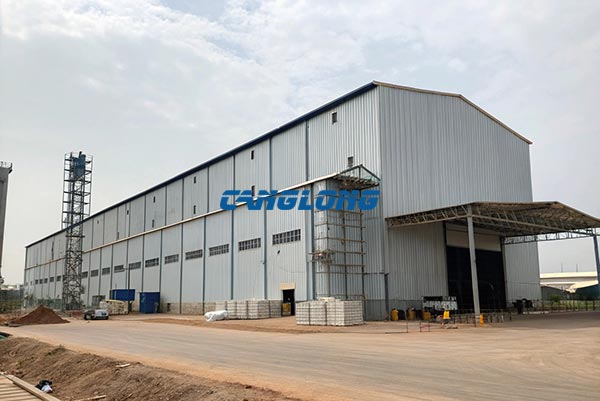
Case 3: Auto Parts Warehouse in Jalisco, Mexico – Modular Fast Delivery
Project background: The high temperature in Mexico in summer reaches 40℃, and the construction of traditional warehouses takes 3 months, which affects the production progress of auto parts companies.
Design solution:
- The Canglong modular prefabrication system is adopted (90% of the components are installed in the factory), and only bolt connection is required on site.
- The thickness of the sandwich panel is 80mm (polyurethane core material, flame retardant B1 grade), and the surface is polyester paint (weather resistance ≥ 10 years).
- The roof integrates solar brackets (reserved 20% load) to meet 30% of the warehouse’s electricity demand.
Project results: It took only 45 days from ordering to delivery. After the warehouse was put into production, the indoor temperature was stabilized below 30℃ (10℃ lower than the outdoor temperature). The customer said that “Canglong’s modular solution allowed us to seize the market 2 months in advance.”
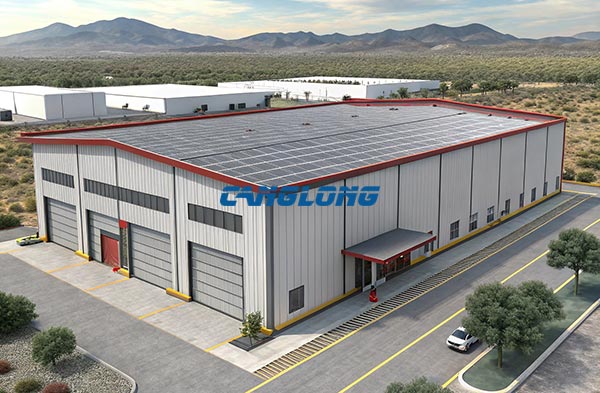
Four. Tropical metal warehouse design, choose the right solution and choose the right supplier
The design of metal warehouses in tropical areas is essentially the art of balancing “climate adaptability” and “functional requirements”. From the thickness of the sandwich panel and the density of the core material, to the wind load calculation of the large-span structure, to the film thickness control of the anti-corrosion coating, every detail determines the life and cost of the warehouse.
With its “global climate database + customized design solution + modular production capacity”, Canglong Group has built “corrosion-resistant, heat-insulating and weather-resistant” benchmark warehouses for many tropical countries. If you are planning a storage project in tropical areas, whether it is dealing with typhoons, high humidity or salt spray, Canglong can provide you with a one-stop solution “from design to delivery”, making metal warehouses a “safe choice” for tropical storage.
